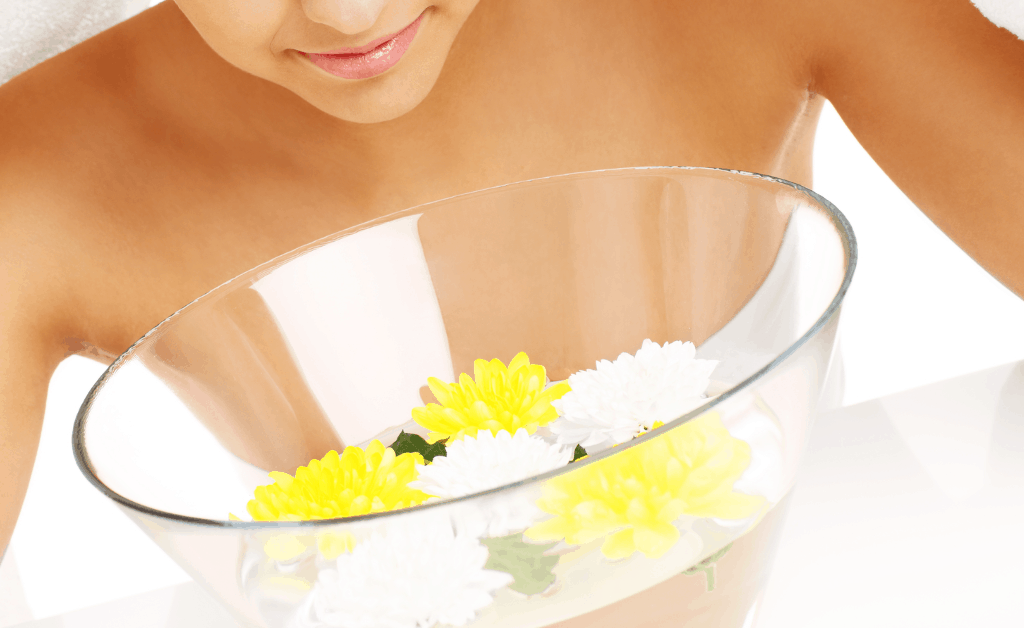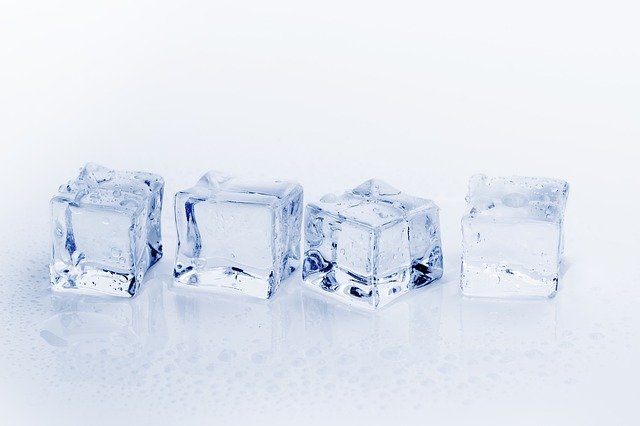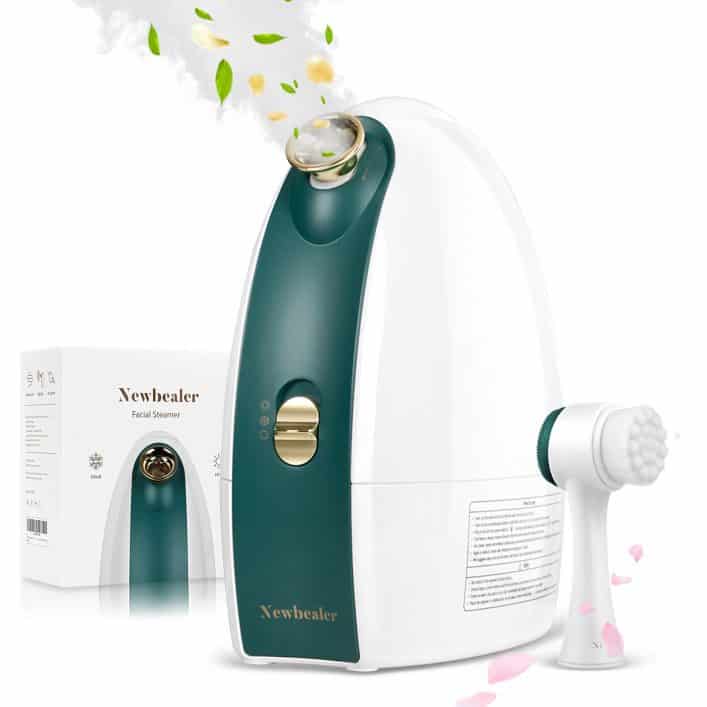Steaming your face is one of the most effective ways to shift dirt, cleanse pores, and boost circulation. It’s also one of the cheapest. Whether you use a bowl and a towel or a professional facial steamer, all you need to perform a relaxing steaming treatment, is water.
But although steaming is a simple process, it doesn’t tend to come with strict instructions like most beauty treatments.
In this guide, we’re going to cover everything you could possibly want to know about facial steaming and answer the no. 1 question people have which is how often should you steam your face. Let’s start by summing up the benefits of this cheap and easy beauty treatment.
Table of Contents
The Main Benefits of Facial Steaming
- Steaming, technically termed ‘thermal ablation’, has been shown to increase the skin’s permeability. This means your skin is much better at absorbing beauty products, moisture, and topical medication following a steam session.
- Steam warms and softens debris and sebum, oil, trapped within the pores, making it much easier to extract.
- Steaming softens blackheads and loosens whiteheads, making it easier for you to get rid of them.
- Face steaming dilates blood vessels to increase blood flow and oxygen for an instant glow.
- Facial steaming promotes the production of collagen and elastin, key proteins for keeping the skin young, firm, and bouncy.
- Steaming helps to relieve congestion caused by colds, by clearing the nasal passages and relieving pressure on the sinuses.
How To Steam Your Face
There are two main ways you can steam your face. The first is a DIY method that anyone can do at home with a bowl and towel. It was the most common way to use steam for your face before the advent of electric face steamers.
Bowl and Towel Method
- Boil your kettle and find a bowl that’s just a little wider at the rim than your face. For bonus points, use water that’s been run through a filter, to make sure it’s free from any impurities.
- Fill your bowl to just under the halfway mark with boiling water, and let it stand for a few minutes. Ideally, the temperature should be 43°C or lower (this is the standard professionals recommend). Keeping the temperature this low will mitigate the risk of steam burns, which can actually be more damaging than hot water burns or scalds.
- When the water has cooled slightly, create a ‘tent’ around your head with a medium-sized towel. It doesn’t have to be airtight – just arranged in a way that keeps most of the steam traveling upwards into your face. Keep your face around 10 to 12 inches from the surface of the water. This again prevents steam burns, while keeping you close enough to reap the benefits.

Using a Home Face Steaming Device
Facial steamers are easy to find online. Thanks to the simplicity of the technology (not much different to your kitchen kettle), they’re affordable too. You’ll still need to fill the tank with water, but they function at the touch of a button, and they’re angled in such a way that creating a makeshift towel tent is less necessary.
The steam outlet should be perfectly positioned so that when you place your steamer on a table or flat surface and pull up a chair, you’ll be at the perfect height and distance to receive maximum benefits.
Home steamers are easy to use. They’re electric units and have varying steam times depending on the size of the water tank. Some steamers come with other skin tools such as to help with blackhead extraction or a facial cleansing brush. Essential oils can also be added to certain types which can help to enhance your steaming experience.
How Often Should You Steam Your Face?
Should you steam every day? Is it bad to steam every day?
Like many other intensive skin treatments for example, exfoliation and dermaplaning, face steaming is not an everyday treatment. Steaming too frequently can put stress on your pores and blood vessels. It can also worsen acne by encouraging too much movement of oil and water around the face. Hot steam can cause redness or inflammation too which is not good for acne.
What Happens if You Steam Every Day?
The combination of warm steam and an increase in perspiration dilates your blood vessels and boosts circulation. In small, concentrated doses, this is healthy and helps to provide the benefits listed at the start of this article.
But if overused, this method exposes your skin to too much stress and stimulation. This can result in inflammation and the worsening of skin conditions. The hot temperatures can also strip natural oils from the skin, leading to excessive dryness.
Opinion is divided as to how often you should steam your face with some suggesting up to 3 times per week. You can certainly steam as often as you feel the need to however once a week is really all that’s necessary.
Face Steaming for Your Particular Skin Type
Face steaming, although a wonderful relaxing and beneficial treatment for skin should be approached with care. Steaming is not a one size fits all treatment. Depending on your unique skin type and any skin concerns or conditions, you’ll need to regulate your steaming activity.
Skin Concerns
Those who suffer from rosacea or active acne should avoid face steaming as it can aggravate such skin conditions and cause redness and possible inflammation with increased blood circulation.
Steaming does hydrate the skin and may benefit dry skin conditions such as eczema, psoriasis or dermatitis but extreme caution is advised. It’s a good idea to check with your doctor or dermatologist to see if your particular skin is suitable for steaming. Even then – steam time should be limited to just a few minutes once a week to see how your skin reacts.
Sensitive Skin
People with highly sensitive skin should also approach face steaming with caution and seek the advice of their medical professional beforehand. Anyone prone to redness in the face should avoid steaming.
Acne or Acne Scars
Steaming can be helpful in the event of blemishes and breakouts. It softens spots and helps clear the oils that clog our pores. Unfortunately, it is not an acne cure.
Acne is a chronic condition caused by bacteria and an imbalance in sebum levels. Steaming may remove existing blockages, but it won’t treat the underlying problem. If you’re struggling with acne, you might need to try a course of medication, or some highly concentrated vitamin A products like Retin-A or tretinoin (these are prescription-based only).
It’s also not an effective treatment for scarring. In order to diminish scars left by acne, you might wish to consider microdermabrasion or vitamin-E-based topical lotions.
Is Steaming Your Face Good for Oily Skin?
Yes. Steam from hot water softens the oils that sit on our skin. This makes it easier to cleanse it away. Oily skin is also likely to handle heat and steaming well.
Is Steaming Good for Dry Skin?
Face steaming is also very suitable for dry skin. Those with dry skin need an extra helping hand when it comes to retaining moisture. Because steaming is so good at improving our skin’s powers of absorption, you can really get the most out of your intensive creams and lotions by steaming beforehand.
The only exception is when the skin is extremely dry and flaky. In this instance, steaming may aggravate inflammation and increase dryness.
Is Face Steaming Good for Pigmentation?
Steaming your face may provide some reduction in pigmentation and hyperpigmentation. This is because it brings oxygen and nutrients to the skin, which in turn promotes the healing of skin tissue. It’s worth noting that this hasn’t been scientifically proven. You’ll also need to steam every week on a long-term basis to start seeing results.
Either way, it won’t eradicate it entirely. If you’re looking to reduce pigmentation in the skin, you might wish to look at vitamin-rich plant oils and chemical exfoliants. Steaming will be helpful in the absorption of plant oils, and may boost their healing benefits.
Does Steaming Your Face Remove Blackheads?
Steaming your face won’t make any type of blemish or imperfection vanish into thin air. However it does make it much easier to release the dirt that causes them.
Blackheads are caused when a hair follicle gets blocked. They are the result of trapped dirt underneath the skin. Steaming your face softens this dirt, making it much easier to extract the blackhead.
Our Top Picks: A closer look at the best facial steamers for home use
How Long Should You Steam Your Face For?
Whichever method you’re using, a ten-minute session is usually plenty of time to soften dirt, boost blood flow, and encourage cleansing perspiration. Any longer, and you risk overheating the skin and putting strain on the capillaries.
For a useful comparison, dermatologists recommend you never spend longer than 15 minutes in a sauna. Any longer and you can start to dehydrate the skin. When you’re steaming, heat is even more concentrated, so a shorter time is recommended.
When you’re using a dedicated steaming device, often, the tank will be small, so may only have the capacity to hold a certain amount of water. On average, a device will be able to produce steam continually for 8-15 minutes, so it’s not usually possible to overrun this time anyway.
If you’re having a facial steaming treatment conducted by a professional in a spa or salon, they may push your time limit to the full 15-20 minutes, but this should only be done at their discretion and under controlled temperature conditions.
Where Does Steaming Fit In My Skincare Routine?
When Should You Steam Your Face?
Many people wonder where their steaming session should fall within their existing skincare routine.
Naturally, when you steam, your pores will release whatever is in them, be it dirt, oil, moisture, or product, and you will perspire. So it’s never a good idea to steam after using products that are designed to stay on the skin like moisturizers, serums, oils, and sunscreen.
But it is a good idea to cleanse before steaming. There’s a risk that anything sitting on your face will find a way into your pores when you steam. Makeup, excess sebum, dead skin cells from dryness, or any residue from products, all have the potential to gain entry to your pores.
So in short, the only thing you should be doing before a steam session is cleansing the skin.
What to do After Steaming?
After steaming your face is where you can start applying your longer-lasting skin care products.
- Following your steam, start by rinsing your face with warm water. Make sure your hands are very clean before doing so, as your pores will still be open and vulnerable to contamination. You might like to finish with a splash of cold water to help tighten your pores back up.
- After you’ve rinsed, sweep a cotton wool ball soaked in toner over the skin to remove any remaining dirt and oil.
- You can then apply your moisturisers, serums, and/or face oils to rehydrate and lock in moisture.
I like to use Paula’s Choice 2% BHA Liquid Exfoliant to help with minimizing large pores. I find it works amazingly well after steaming my face and really helps with oily skin.

More in Skin Care – Best Toner for Combination Skin
Can You Apply Ice After Steaming Your Face?
Although it seems like putting your skin through two extremes, you can apply ice after a steam session. This is known as a ‘vascular flush’.
Heat opens the pores and promotes circulation by dilating the blood vessels. Ice then closes the pores and helps to shrink the blood vessels. This is great for circulation and overall skin health. Just make sure you’ve rinsed and ideally toned the skin first, to prevent dirt from getting locked back in.
Scrub After Steaming?
As well as cleansing, you might choose to exfoliate before a steam. This sweeps away all of the dead skin cells that may clog up open pores.
It’s generally advised to avoid exfoliating after steaming. After the heat inflicted by the steam, your skin will be extra sensitive. Scrubbing can be harsh on the skin, and you may risk clogging up the pores again. Microparticles in exfoliating scrubs are something else that could potentially block pores..
The best advice in skincare is always not to overdo it. Since steaming is only really needed once a week, it’s easy to dedicate 1-2 other days of the week to exfoliation.
Mask After Steaming?
This is another one which is somewhat up for debate.
After steaming, your skin will love a rehydrating treatment and will be very receptive to moisture. A hydrating sheet mask is great to use after a steam. A peel-off mask can be extra effective at pulling out any residual dirt, too.
However, if you’re talking about scrub masks or drying clays, it’s better to use them on days where your skin is less sensitive.
When Should You Avoid Steaming Your Face?
Face steaming is generally safe, but those who suffer from active acne and rosacea should avoid it. It can help with dry skin conditions but for anyone with very flaky, highly sensitive, and easily irritated skin, you should also avoid it. Speaking to a medical professional is highly recommended beforehand.
If you’re a complete beginner to steaming, start with just a couple of minutes and work your way up. It’s a good idea to try 4-5 minutes instead of a full 10 the first time you steam.
Enhance Your Steaming Experience
For a final note on your ultimate steaming experience, why not step it up a notch with some luxurious and nourishing additions? Some suggestions for dropping into your bowl or steamer include:
- Apple cider vinegar to help balance the pH levels of the skin
- Herbs like the astringent parsley, detoxifying mint, or soothing chamomile
- Essential oils, which are famed to hold a wide range of benefits for the skin.
These are all easy to add if you are steaming using a bowl and hot water. If however, you are using an electric face steamer, not all models are equipped for anything other than water. There are some models of course where you can add essential oils and something like this steamer where you can add herbs, flowers or oils. Happy steaming whatever method you use.



